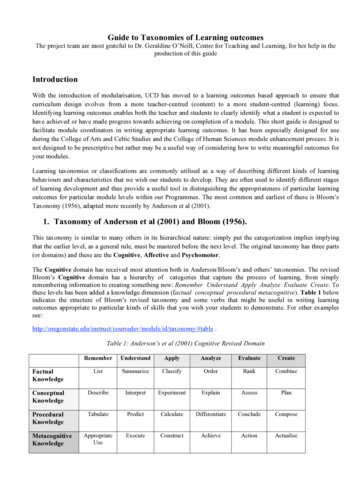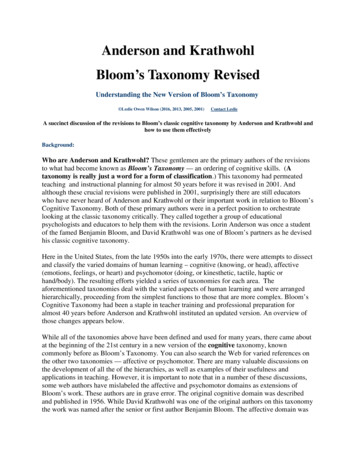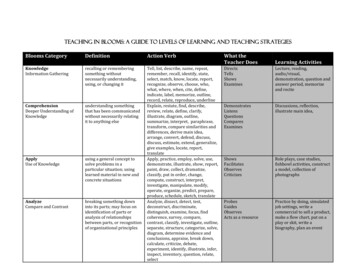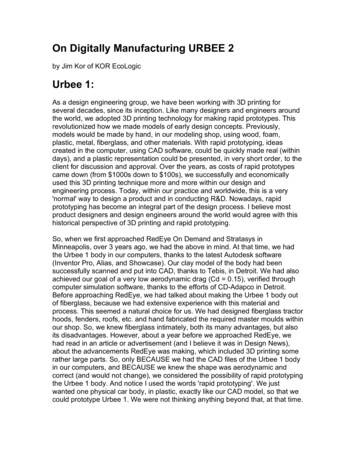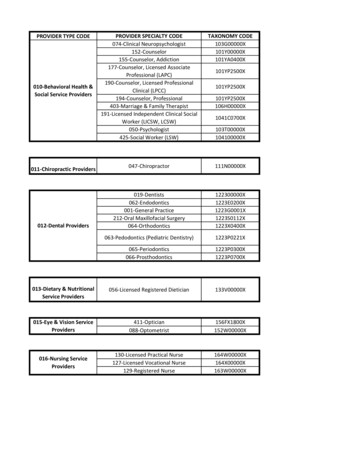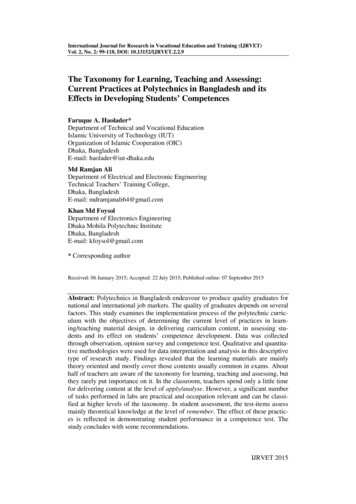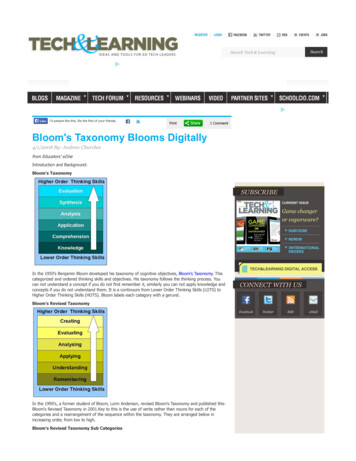
Transcription
REGISTERLOGINFACEBOOKTWITTERRSSEVENTSSearch Tech & LearningBLOGSMAGAZINETECH FORUMLike 74 people like this. Be the first of your friends.RESOURCESWEBINARSPrintVIDEOPARTNER SITESSCHOOLCIO.COM1 CommentBloom's Taxonomy Blooms Digitally4/1/2008 By: Andrew Churchesfrom Educators' eZineIntroduction and Background:Bloom's TaxonomySUBSCRIBECURRENT ISSUEGame changeror vaporware?SUBCRIBERENEWINTERNATIONALORDERSIn the 1950's Benjamin Bloom developed his taxonomy of cognitive objectives, Bloom's Taxonomy. Thiscategorized and ordered thinking skills and objectives. His taxonomy follows the thinking process. Youcan not understand a concept if you do not first remember it, similarly you can not apply knowledge andconcepts if you do not understand them. It is a continuum from Lower Order Thinking Skills (LOTS) toHigher Order Thinking Skills (HOTS). Bloom labels each category with a gerund.Bloom's Revised TaxonomyIn the 1990's, a former student of Bloom, Lorin Anderson, revised Bloom's Taxonomy and published thisBloom's Revised Taxonomy in 2001.Key to this is the use of verbs rather than nouns for each of thecategories and a rearrangement of the sequence within the taxonomy. They are arranged below inincreasing order, from low to high.Bloom's Revised Taxonomy Sub CategoriesCONNECT WITH USJOBS
Each of the categories or taxonomic elements has a number of key verbs associated with itLower Order Thinking Skills (LOTS)Remembering - Recognising, listing, describing, identifying, retrieving, naming, locating, findingUnderstanding - Interpreting, Summarising, inferring, paraphrasing, classifying, comparing,explaining, exemplifyingApplying - Implementing, carrying out, using, executingAnalysing - Comparing, organising, deconstructing, Attributing, outlining, finding, structuring,integratingEvaluating - Checking, hypothesising, critiquing, Experimenting, judging, testing, Detecting,MonitoringCreating - designing, constructing, planning, producing, inventing, devising, makingHigher Order Thinking Skills (HOTS)The elements cover many of the activities and objectives but they do not address the new objectivespresented by the emergence and integration of Information and Communication Technologies into theclassroom and the lives of our students.Bloom's digital taxonomy mapKey:Elements coloured in black are recognised and existing verbs, Elements coloured in blue are new digitalverbs.RememberingThis element of the taxonomy does infer the retrieval of material. This is a key element given the growthin knowledge and information.The digital additions and their explanations are as follows:Bullet pointing – This is analogous to listing but in a digital format.Highlighting – This is a key element of most productivity suites; encouraging students to pickout and highlight key words and phrases is a technique for recall.Bookmarking or favorite-ing – this is where the students mark for later use web sites,resources and files. Students can then organise these.Social networking – this is where people develop networks of friends and associates. It forgesand creates links between different people. Like social bookmarks (see below) a social networkcan form a key element of collaborating and networking.Social bookmarking – this is an online version of local bookmarking or favorites, It is moreadvanced because you can draw on others' bookmarks and tags. While higher order thinking skillslike collaborating and sharing, can and do make use of these skills, this is its simplest form - asimple list of sites saved to an online format rather than locally to the machine.Searching or "Googling" - Search engines are now key elements of students' research. At its
simplest the student is just entering a key word or phrase into the basic entry pane of the searchengine. This skill does not refine the search beyond the key word or term.Key Terms - Remembering:Recognizing, listing, describing, identifying, retrieving, naming, locating,finding, Bullet pointing, highlighting, bookmarking, social networking, Socialbookmarking, favorite-ing/local bookmarking, Searching, Googling.UnderstandingThe digital additions and their explanations are as follows:Advanced and Boolean Searching – This is a progression from the previous category.Students require a greater depth of understanding to be able to create, modify and refinesearches to suit their search needs.Blog Journaling – This is the simplest of the uses for a blog, where a student simply "talks""writes" or "types" a daily- or task-specific journal. This shows a basic understanding of theactivity reported upon. The blog can be used to develop higher level thinking when used fordiscussion and collaboration.Twittering – The Twitter site's fundamental question is "what are you doing?" This can be, in itsmost simplistic form, a one or two word answer, but when developed this is a tool that lends itselfto developing understanding and potentially starting collaboration.Categorizing – digital classification - organizing and classifying files, web sites and materialsusing folders etc.Commenting and annotating – a variety of tools exist that allow the user to comment andannotate on web pages, .pdf files and other documents. The user is developing understanding bysimply commenting on the pages. This is analogous with writing notes on hand outs, but ispotentially more powerful as you can link and index these.Subscribing – Subscription takes bookmarking in its various forms and simplistic reading onelevel further. The act of subscription by itself does not show or develop understanding but oftenthe process of reading and revisiting the subscribed-to feeds leads to greater understanding.Key Terms - Understanding:Interpreting, Summarizing, inferring, paraphrasing, classifying, comparing,explaining, exemplifying, Advanced searching, Boolean searching, blogjournaling, twittering, categorising and tagging, commenting, annotating,subscribing.ApplyingThe digital additions and their justifications are as follows:Running and operating – This is the action of initiating a program or operating andmanipulating hardware and applications to obtain a basic goal or objective.Playing – The increasing emergence of games as a mode of education leads to the inclusion ofthis term in the list. Students who successfully play or operate a game are showing understandingof process and task and application of skills.Uploading and Sharing - uploading materials to websites and the sharing of materials via siteslike flickr etc. This is a simple form of collaboration, a higher order thinking skill.Hacking – hacking in its simpler forms is applying a simple set of rules to achieve a goal orobjective.Editing – With most media, editing is a process or a procedure that the editor employs.Key Terms - Applying:Implementing, carrying out, using, executing, running, loading, playing,operating, hacking, uploading, sharing, editing.
AnalysingThe digital additions and their explanations are as follows:Mashing – mash ups are the integration of several data sources into a single resource. Mashingdata currently is a complex process but as more options and sites evolve this will become anincreasingly easy and accessible means of analysis.Linking – this is establishing and building links within and outside of documents and web pages.Reverse-engineering – this is analogous with deconstruction. It is also related to cracking oftenwith out the negative implications associated with this.Cracking – cracking requires the cracker to understand and operate the application or systembeing cracked, analyse its strengths and weaknesses and then exploit these.Validating – With the wealth of information available to students combined with the lack ofauthentication of data, students of today and tomorrow must be able to validate the veracity oftheir information sources. To do this they must be able to analyse the data sources and makejudgements based on these.Tagging – This is organising, structuring and attributing online data, meta-tagging web pagesetc. Students need to be able understand and analyse the content of the pages to be able to tagit.Key Terms - Analysing:Comparing, organising, deconstructing, Attributing, outlining, finding,structuring, integrating, Mashing, linking, reverse-engineering, cracking,mind-mapping, validating, tagging.EvaluatingThe digital additions and their explanations are as follows:Blog/vlog commenting and reflecting – Constructive criticism and reflective practice areoften facilitated by the use of blogs and video blogs. Students commenting and replying topostings have to evaluate the material in context and reply.Posting – posting comments to blogs, discussion boards, threaded discussions. These areincreasingly common elements of students' daily practice. Good postings like good comments, arenot simple one-line answers but rather are structured and constructed to evaluate the topic orconcept.Moderating – This is high level evaluation; the moderator must be able to evaluate a posting orcomment from a variety of perspectives, assessing its worth, value and appropriateness.Collaborating and networking – Collaboration is an increasing feature of education. In a worldincreasingly focused on communication, collaboration leading to collective intelligence is a keyaspect. Effective collaboration involves evaluating the strengths and abilities of the participantsand evaluating the contribution they make. Networking is a feature of collaboration, contactingand communicating with relevant person via a network of associates.Testing (Alpha and Beta) – Testing of applications, processes and procedures is a key element inthe development of any tool. To be an effective tester you must have the ability to analyze thepurpose of the tool or process, what its correct function should be and what its current functionis.Key Terms – Evaluating:Checking, hypothesising, critiquing, experimenting, judging, testing,detecting, monitoring, (Blog/vlog) commenting, reviewing, posting,moderating, collaborating, networking, reflecting, (Alpha & beta) testing.CreatingThe digital additions and their explanations are as follows:
Programming – Whether it is creating their own applications, programming macros ordeveloping games or multimedia applications within structured environments, students areroutinely creating their own programs to suit their needs and goals.Filming, animating, videocasting, podcasting, mixing and remixing – these relate to theincreasing availability of multimedia and multimedia editing tools. Students frequently capture,create, mix and remix content to produce unique products.Directing and producing – to directing or producing a product, performance or production is ahighly creative process. It requires the student to have vision, understand the components andmeld these into a coherent product.Publishing – whether via the web or from home computers, publishing in text, media or digitalformats is increasing. Again this requires a huge overview of not only the content beingpublished, but the process and product. Related to this concept are also Video blogging – theproduction of video blogs, blogging and also wiki-ing - creating, adding to and modify contentin wikis. Creating or building Mash ups would also fit here.Key Terms – Creating:designing, constructing, planning, producing, inventing, devising, making,programming, filming, animating, Blogging, Video blogging, mixing,remixing, wiki-ing, publishing, videocasting, podcasting,directing/producing, creating or building mash ups.BibliographyChurches, A. 2007, Educational Origami, Bloom's and ICT ToolsAnderson, L.W., and D. Krathwohl (Eds.) (2001). A Taxonomy for Learning, Teaching and Assessing: aRevision of Bloom's Taxonomy of Educational Objectives. Longman, New York.Acknowledgements: For assistance, discussion and often punctuation:Miguel Guhlin, Sheryl NussbaumBeach, Alan Knightbridge, Sue Cattell, Raewyn Casey, Marg McLeod, Doug DeKockEmail: Andrew ChurchesSponsoredLike 74 people like this. Be the first of your friends.Print1 Comment
1 comment 0Join the discussion BestCommunityTina MischkeShare My Disqus Johanna6 months agoI saw a few grammatical errors but I enjoyed reading all the new technological terms asthey apply to HOTS. Reply Share ›ALSO ON TECHLEARNINGWHAT'S THIS?Study: Music Program Boosts LiteracyDevelopmentFrom the Principal's Office: BYOD andthe Paperless Classroom2 comments 2 months ago1 comment a month agoScott Elliot — I had the good fortune toTracy Pouncy — Mrs. Smith- I can see wheredirect this study. It was fascinating to see thesubstantial impact the music-based this would be very engaging. What websitedo you feel works best - as the teacher From the Principal's Office: Why I Don'tTrust SAS and EVASS DataWhy You Can’t Click “Publish”1 comment 18 days ago1 comment 2 months agoGahe — I think that your perspective is deep,its just well thought out and really fantasticto see someone who knows how to put Pinksquad — The EVAAS models areavailable here: http://www.sas.com/resources/a. SubscribedAdd Disqus to your siteBlogsSUBSCRIBECUSTOMER SERVICECONTACT USABOUT USENEWSLETTERSADVERTISINGEd Tech TickerMagazinesNews & TrendsTech ForumResourcesTL Advisor BlogAtlantaProductsCaliforniaBuyer's GuideTech&Learning InternationalFeaturesBostonEbooksEditor's DeskChicagoT&L UNew YorkiQ CatalogIssuesTexasPD TipsCurrent IssuesArchiveContestsSchoolCIO SummitsSite of the DayWebinarsVideoK12 BlueprintSchoolCIO.comDigital Learning EnvironmentsSchoolCIO SummitsCopyright 2012 NewBay Media, LLC. 28 East 28th Street, 12th Floor, New York, NY 10016T (212) 378-0400F (212) 378-0470
A Taxonomy for Learning, Teaching and Assessing: a Revision of Bloom's Taxonomy of Educational Objectives. Longman, New York. Acknowledgements: For assistance, discussion and often punctuation:Miguel Guhlin, Sheryl Nussbaum-Beach, Alan Knightbridge, Sue Cattell, Raew
